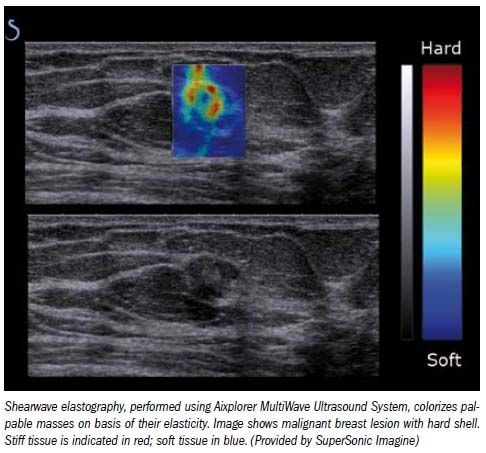Shearwave elastography improves breast lesion Dx
Reducing the number of breast biopsies by better classifying suspicious lesions noninvasively could improve healthcare and cut healthcare costs, laudable goals in the current era of healthcare-and economic-reform.
Reducing the number of breast biopsies by better classifying suspicious lesions noninvasively could improve healthcare and cut healthcare costs, laudable goals in the current era of healthcare-and economic-reform. Shearwave ultrasound elastography, cleared by the FDA in August 2009 as part of SuperSonic Imagine's Aixplorer, may do the trick.
Results from the first phase of a multicenter international clinical trial, released in April, show that data obtained using shearwave elastography, when added to the BI-RADS score for characterizing breast tumors, significantly improves diagnostic specificity and sensitivity, increasing the percentage of correctly classified lesions and improving lesion diagnosis.

The multicenter trial is looking at how the technology might add specificity to an assessment done with conventional B mode imaging, which focuses on morphological features of a mass or other abnormality.
Benign lesions, for example, are typically oriented parallel to the skin, have circumscribed margins, and are oval or macrolobulated in shape. Commonly, malignant masses have irregular shapes, indistinct or spiculated margins, and are “taller than wide.”
“Features of benign and malignant lesions, however, can overlap,” said Dr. Ellen Mendelson, breast imaging section chief at Northwestern Memorial Hospital and site principal investigator for the trial at Northwestern.
The multicenter research is trying to nail down exactly how shearwave elastography might be used to help make the distinction between benign and malignant tissue. In the meantime, current users of the Aixplorer, which has been on the U.S. market for almost a year, can benefit from the improved diagnostic confidence in distinguishing benign and malignant lesions.
“Particularly appealing about this method of elastography is decreased operator dependence and greater likelihood of reproducible results,” Mendelson said.
Other methods of assessing elasticity rely on manual compression of breast tissue with the transducer. In shearwave elastography, no such compression is needed. Data obtained on the first 1000 patients in the 17-center trial suggest that improved characterization is achieved regardless of operator skill.
“The technique is more standardized and reproducible over time,” she said.
New AI-Enabled Portable Ultrasound May Facilitate 50 Percent Reduction in Cardiac Imaging Scan Time
March 28th 2025Artificial intelligence (AI)-powered measurement capabilities provide key features with the Compact Ultrasound 5500CV device, which was unveiled at the American College of Cardiology (ACC) conference.
The Reading Room: Racial and Ethnic Minorities, Cancer Screenings, and COVID-19
November 3rd 2020In this podcast episode, Dr. Shalom Kalnicki, from Montefiore and Albert Einstein College of Medicine, discusses the disparities minority patients face with cancer screenings and what can be done to increase access during the pandemic.
Can Ultrasound-Based Radiomics Enhance Differentiation of HER2 Breast Cancer?
March 11th 2025Multicenter research revealed that a combined model of clinical factors and ultrasound-based radiomics exhibited greater than a 23 percent higher per patient-level accuracy rate for identifying HER2 breast cancer than a clinical model.